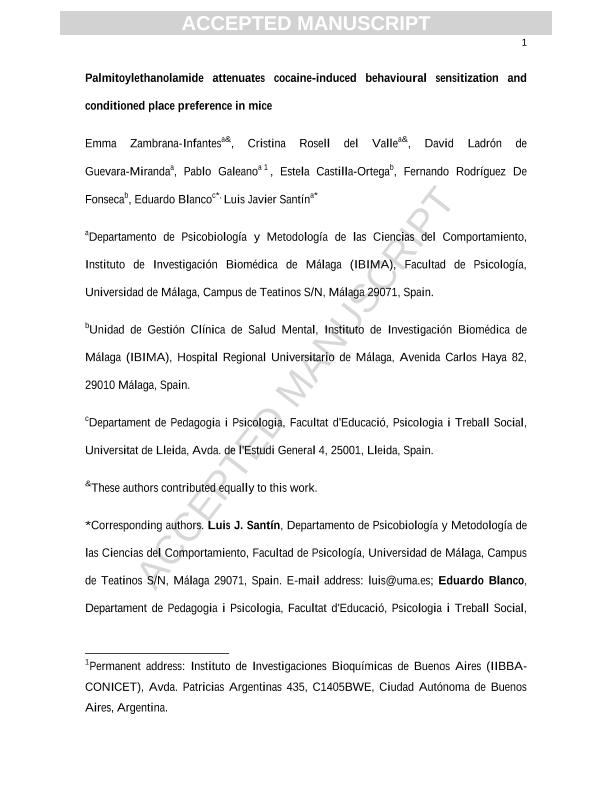Mostrar el registro sencillo del ítem
dc.contributor.author
Zambrana Infantes, Emma
dc.contributor.author
Rosell del Valle, Cristina
dc.contributor.author
Ladrón de Guevara Miranda, David
dc.contributor.author
Galeano, Pablo

dc.contributor.author
Castilla Ortega, Estela
dc.contributor.author
Rodríguez De Fonseca, Fernando
dc.contributor.author
Blanco, Eduardo
dc.contributor.author
Santín, Luis Javier
dc.date.available
2022-02-03T17:05:05Z
dc.date.issued
2018-03
dc.identifier.citation
Zambrana Infantes, Emma; Rosell del Valle, Cristina; Ladrón de Guevara Miranda, David; Galeano, Pablo; Castilla Ortega, Estela; et al.; Palmitoylethanolamide attenuates cocaine-induced behavioral sensitization and conditioned place preference in mice; Pergamon-Elsevier Science Ltd; Pharmacology Biochemistry and Behavior; 166; 3-2018; 1-58
dc.identifier.issn
0091-3057
dc.identifier.uri
http://hdl.handle.net/11336/151289
dc.description.abstract
Cocaine addiction is a chronically relapsing disorder characterized by compulsive drug-seeking and drug-taking behaviors. Previous studies have demonstrated that cocaine, as well as other drugs of abuse, alters the levels of lipid-based signaling molecules, such as N-acylethanolamines (NAEs). Moreover, brain levels of NAEs have shown sensitivity to cocaine self-administration and extinction training in rodents. Given this background, the aim of this study was to investigate the effects of repeated or acute administration of palmitoylethanolamide (PEA), an endogenous NAE, on psychomotor sensitization and cocaine-induced contextual conditioning. To this end, the potential ability of repeated PEA administration (1 or 10 mg/kg, i.p.) to modulate the acquisition of cocaine-induced behavioral sensitization (BS) and conditioned place preference (CPP) was assessed in male C57BL/6J mice. In addition, the expression of cocaine-induced BS and CPP following acute PEA administration were also studied. Results showed that repeated administration of both doses of PEA were able to block the acquisition of cocaine-induced BS. Furthermore, acute administration of both doses of PEA was able to abolish the expression of BS, while the highest dose also abolished the expression of cocaine-induced CPP. Taken together, these results indicate that exogenous administration of PEA attenuated psychomotor sensitization, while the effect of PEA in cocaine-induced CPP depended on whether PEA was administered repeatedly or acutely. These findings could be relevant to understand the role that NAEs play in processes underlying the development and maintenance of cocaine addiction.
dc.format
application/pdf
dc.language.iso
eng
dc.publisher
Pergamon-Elsevier Science Ltd

dc.rights
info:eu-repo/semantics/openAccess
dc.rights.uri
https://creativecommons.org/licenses/by-nc-nd/2.5/ar/
dc.subject
COCAINE
dc.subject
CONDITIONED LOCOMOTION
dc.subject
CONDITIONED PLACE PREFERENCE
dc.subject
LOCOMOTOR SENSITIZATION
dc.subject
PALMITOYLETHANOLAMIDE
dc.subject.classification
Neurociencias

dc.subject.classification
Medicina Básica

dc.subject.classification
CIENCIAS MÉDICAS Y DE LA SALUD

dc.title
Palmitoylethanolamide attenuates cocaine-induced behavioral sensitization and conditioned place preference in mice
dc.type
info:eu-repo/semantics/article
dc.type
info:ar-repo/semantics/artículo
dc.type
info:eu-repo/semantics/publishedVersion
dc.date.updated
2019-10-22T17:53:45Z
dc.identifier.eissn
1873-5177
dc.journal.volume
166
dc.journal.pagination
1-58
dc.journal.pais
Estados Unidos

dc.description.fil
Fil: Zambrana Infantes, Emma. Universidad de Málaga; España
dc.description.fil
Fil: Rosell del Valle, Cristina. Universidad de Málaga; España
dc.description.fil
Fil: Ladrón de Guevara Miranda, David. Universidad de Málaga; España
dc.description.fil
Fil: Galeano, Pablo. Universidad de Málaga; España. Consejo Nacional de Investigaciones Científicas y Técnicas. Oficina de Coordinación Administrativa Parque Centenario. Instituto de Investigaciones Bioquímicas de Buenos Aires. Fundación Instituto Leloir. Instituto de Investigaciones Bioquímicas de Buenos Aires; Argentina
dc.description.fil
Fil: Castilla Ortega, Estela. Hospital Regional Universitario de Málaga; España
dc.description.fil
Fil: Rodríguez De Fonseca, Fernando. Hospital Regional Universitario de Málaga; España
dc.description.fil
Fil: Blanco, Eduardo. Universidad de Lleida; España
dc.description.fil
Fil: Santín, Luis Javier. Universidad de Málaga; España
dc.journal.title
Pharmacology Biochemistry and Behavior

dc.relation.alternativeid
info:eu-repo/semantics/altIdentifier/url/https://www.sciencedirect.com/science/article/pii/S0091305717305981
dc.relation.alternativeid
info:eu-repo/semantics/altIdentifier/doi/http://dx.doi.org/10.1016/j.pbb.2018.01.002
Archivos asociados
